Haumea
Contents
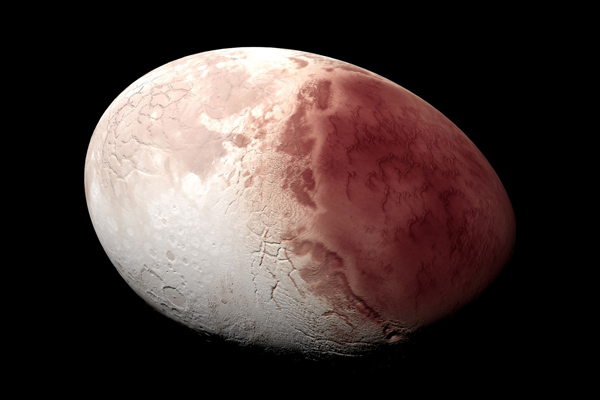 Artist's impression of the dwarf planet Haumea / deviantart.com
Artist's impression of the dwarf planet Haumea / deviantart.comHaumea is a very unusual planet located in the Kuiper Belt beyond Neptune. Only recently discovered, there is little known about this distant Trans-Neptunian Object other than its odd shape and axial rotational speed.
Discovery
The discovery of Haumea is still on debate. Micheal Brown and his team of astronomers stake claim on Haumea's discovery from images of the distant object back in May of 2004. In July of 2005, Mr. Brown submitted an online abstract report of their discovery for review. On July 27, 2005, JosÃѓÂ© Luis Ortiz Moreno and his team from the Instituto de AstrofÃѓÂÂsica de AndalucÃѓÂÂa at Sierra Nevada Observatory in Spain sent an email to the Minor Planet Center claiming they had discovered a new planet from images taken in March of 2003. With the discovery of Haumea in question, when announced by the IAU that Haumea was a dwarf planet, the Sierra Nevada Observatory in Spain was listed as the place of discovery while the name proposed for the newly discovered planet by the CalTech team was used.
Position to the Sun
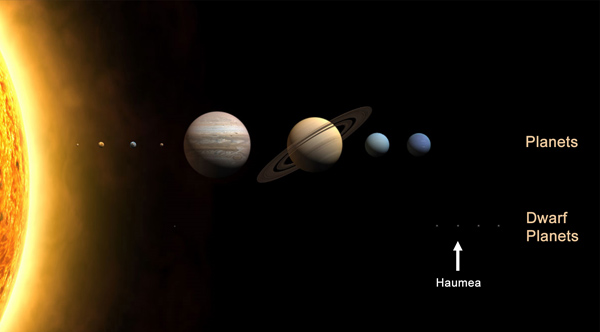 Position of Haumea in the Solar System / nasa.gov
Position of Haumea in the Solar System / nasa.govHaumea is approximately 6.4 billion km (4 billion miles) from the sun and takes about 283 years to complete its rotation. It is one of the most unusual planetary objects in its axial rotation takes approximately 4 hours to complete making it the fastest-spinning large object in the solar system. Its quick spin causes it to have an elonged shape at its equator, similar to an America Football or Rugby ball. Like Pluto and Eris, Haumea does not rotate "around" the sun but more at a circular angle over and around the sun which is at an inclination of approximately 82°.
Internal Structure
Little to no information is available for its internal structure at this time. Based on its moons orbital behavior, it is believed that the planets mass is 6% of Earth's moon which indicates a rocky core and thin mantle. However, because of its distance we are unable to get a better idea of whether that is factual or not. There is a giant red spot on the spectral images of the planet that some astronomers believe may give a better assessment as to what the internal structure of this planet may contain. However, as astronomer Pedro Lacerda stated in his paper on this red spot "It's all very speculative".
Surface/Geography
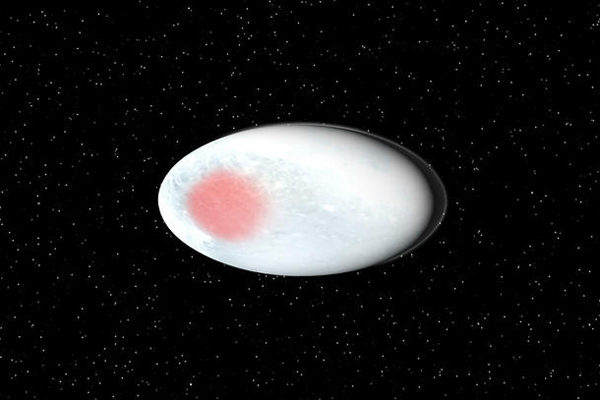 Another artist's impression of Haumea / co.uk
Another artist's impression of Haumea / co.ukThere are no images yet of Haumea but is known is that the planet is covered in a crystalline ice on the surface very much like Pluto's moon Charon. This has astronomers baffled as the temperatures on the planet's surface suggest that there should be amorphous ice on the surface instead. Amorphous ice happens through rapid cooling which hinders crystalline ice from forming. This gives the idea that the icy layer on the surface is fairly new, within 10 million years, and/or there may be some sort of geological activity that occurs on the surface. Of course, this is mere speculation at this point in time.
Haumea has a high albedo, the third highest in the solar system. It is approximately 0.6 to 0.8 making it almost as bright as snow on Earth. This is due to the crystalline ice that covers its surface reflecting 75% to 80% of all light that reaches it.
Spectra analysis of the planet shows a lack of ammonia hydrate which eliminates the possibility of cryovolcanism occurring on the surface. However, there is a strong belief that Haumea may have a mottled surface similar to Pluto's due to a large red spot that was discovered on the bright white spectra back in 2009. It is unclear what this red spot may be but the theory is that this area may have been the site of an impact and contains high concentrations of minerals and organic compounds.
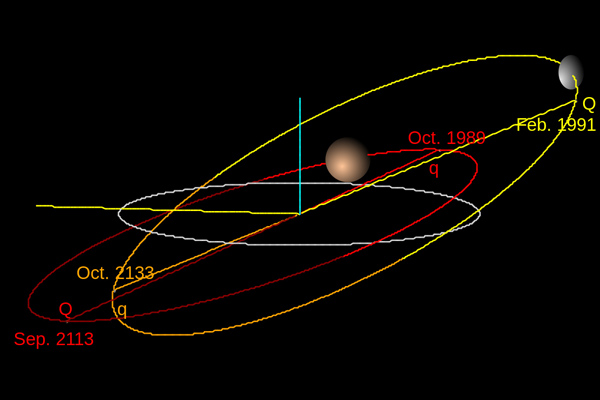 Orbits of Haumea (yellow) and Pluto (red) / wikimedia.org
Orbits of Haumea (yellow) and Pluto (red) / wikimedia.orgOne reasoning for the idea of the red spot being from an impact is explained in a paper written by Pedro Lacerda. He explains that the fact that the surface has a crystalline layer and there is a bright red spot suggest that at one time there was a moment of extreme warming. This is the only explanation for the crystalline layer when there should be an amorphous one. "The fact that I think I find more crystalline water on the spot means that the temperature on the spot may have been a little bit higher in the past, so it may have been heated right there," Lacerda says. To read more please visit The Astronomical Journal Website to view the entire article.
Based on its elongated shaped, Haumea is estimated to be 1,960 km (1,218 miles) in diameter at its longest points and only 996 km (619 miles) at its shortest points. This awkward shape is due to its fast rotation on its axis causing an extreme bulge at its equator and a flattening effect on its North and South poles similar to Earth, only more extreme. This is what attributes to its famous American Football shape that Haumea is most identified by.
Atmosphere/Climate
Because of the distance of Trans-Neptunian objects such as Haumea, getting precise information on its design and makeup is very difficult and mostly based on speculation. Using a spectral telescope they have been able to determine that its atmosphere consists primarily of methane, ethane and possibly nitrogen ices. Its temperature is approximate -223°C (-369.4°F) which means that it remains in a frozen state.
Moons
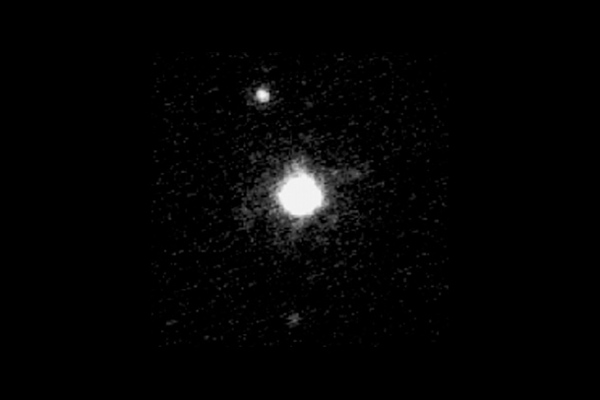 Keck image of Haumea, with moons Hi'iaka and Naumaka / caltech.edu
Keck image of Haumea, with moons Hi'iaka and Naumaka / caltech.eduHaumea has two moons that orbit the planet. Discover in 2005 by Browns team at CalTech, they were named after Haumea's two daughters Hi'iaka and Namaka. Unlike their parent planet, there was no question on who discovered them. For more information on Haumea's two moons, see Haumea's Moons and Satellites.
Exploration
Currently, there have been no missions to this distant planet or any planned. With its distance being so far, 50 times further from the sun than Earth, to send a probe to investigate is both very expensive and time-consuming.
See also: All planets, Dwarf planets, Objects
Video Gallery

-
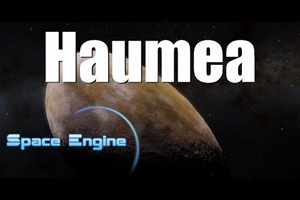 Haumea - the odd dwarf planet
Haumea - the odd dwarf planet
-
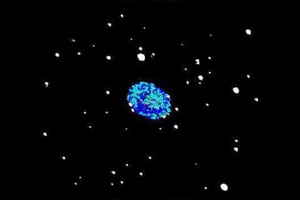 Formation Model of Haumea
Formation Model of Haumea
-
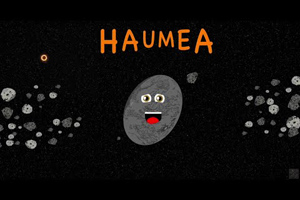 Haumea: Song for kids
Haumea: Song for kids